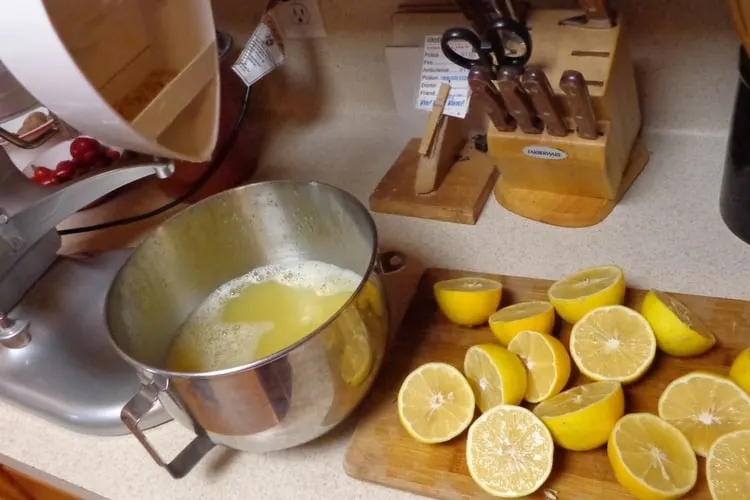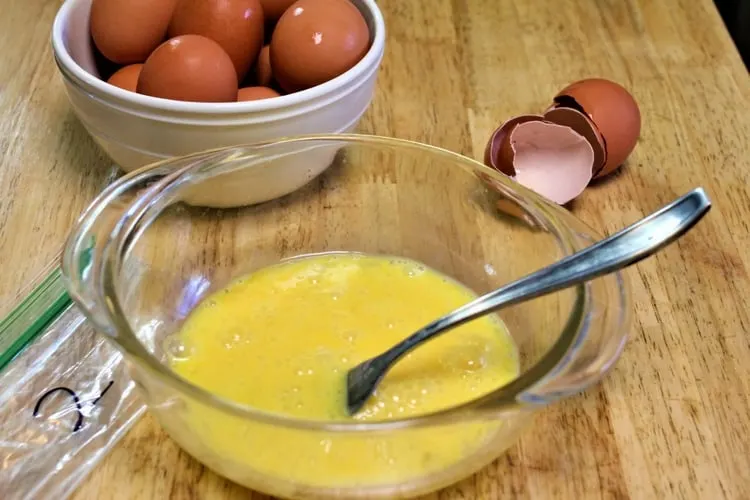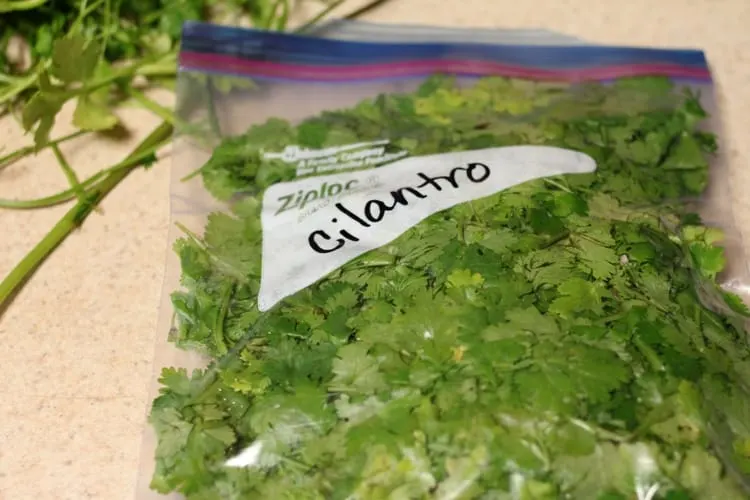After hurricane Harvey we were without power for eight days. We didn’t stay in our home during that time but did come daily to work on starting the clean up and to check on things. We were totally fine but one thing I was mourning was losing everything in my freezers. You see I have a huge deep freeze and it was full of food. On day five my husband set up an outdoor canning kitchen for me and I canned all the fruit – but that’s another post for another day. Today I want to talk about freezing foods you didn’t know you could freeze.
When we finally got power and went back home the first order of business was to clean out the deep freeze and the inside refrigerator. I had to list all of our losses for our insurance company and the food loss was included in that. When I showed the list to the adjuster he kept saying, “You can freeze that?” I guess he wasn’t used to seeing a list of mainly homegrown food but I wanted to be sure I was being fair in assessing our losses since most of the things in the freezer were things we grew or foraged.
 Freezing Eggs
Freezing Eggs
Every spring we get more eggs than we can eat then in the winter we get no eggs. I’m sure it’s the same at your place if you have chickens. We used to sell the excess but a few years ago I started freezing them to use in the winter. Here’s the key to freezing eggs, you need to beat them first. I like to beat two eggs at a time, then put them in a snack size baggie and write the number 2 on it. I also like to freeze some in sandwich size bags which can easily hold six eggs. I write the number 6 on those. Freeze these flat and they won’t take up much space at all.
To use, you can thaw on the counter or put the bag in a glass of warm water. It just takes minutes for it to thaw in water. I like to snip one of the bottom corners off to get the eggs out. I’ve used them in things like baked goods and pancakes but I’ve also made scrambled eggs with them, no one can tell that I used frozen eggs.
Freezing Potatoes
I’ve only figured out one way to freeze potatoes so that the texture is good once they’re thawed. Cream cheese is the key. I’m not sure why it works but it does. In order to freeze potatoes, first boil them and drain off the water. Then mash them. Go ahead and season them but instead of putting butter in them (or in addition to butter ) put 8oz of cream cheese. I use a block of cream cheese for about 2lbs of potatoes.
Freeze them in a zip lock bag, these will stack nicely in your freezer and not take up a lot of space. You can reheat them several ways. You can thaw them some either by leaving them on a plate on the counter or in a sink of water. They don’t need to be thawed all the way, just enough to get them out of the bag and into a container. You can put them in a bowl and microwave them, stirring every couple of minutes. There will be quite bit of water, try not to freak out. Just keep stirring and microwaving until the consistency is good. If you just can’t stand the water, you can pour some off.
You can reheat frozen potatoes in the oven using a baking dish. If you do it this way, some of the water will evaporate off. But you need to heat them until they are hot throughout and not just on the edges. Stirring occasionally will help. Lastly, you can use reheat them in a crock pot. Just dump them in and set the heat on low. Stirring occasionally will help heat them evenly.
Freezing Cucumbers
Freezing cucumbers is only a good idea if you know what you’re going to do with them. I like to infuse my water with cucumber so I freeze them during the summer so I have organic cucumbers for my water year round. To freeze, slice the cucumber and lay it out on a baking sheet (I like to line it with parchment first). Put in the freezer for several hours. Once the cucumbers are frozen, take them out of the freezer, put them in a zip lock bag and put them back into the freezer.
Fruits can also be frozen this way. Freezing them on the baking sheet first will keep them from sticking together when you freeze them in the zip lock bag.
Freezing Corn on the Cob
Years ago while buying corn at the farmer’s market an older lady told me how she always froze her corn, and I’ve done it that way ever since. It works great and there’s no blanching involved.
To freeze corn on the cob the easy way, just chop off the tip of the corn (especially if the farmer doesn’t use pesticides as there is a good chance there will be a few worms eating the tips). I also like to cut off the part that attaches to the plant so that they fit into freezer bags a bit better. Then put them in freezer bags and freeze – don’t shuck them.
To cook frozen corn, don’t remove the husks until after they are cooked. You can microwave them for a minute or two. You can also boil them. I like to bring the water to a boil, then add the frozen corn and bring it back to a boil, then boil them for about 5 minutes. After the corn on the cob is cooked, put it on a platter to cool just a bit and then remove the husks and silks. The silks should come out fairly easily.

Freezing Citrus
Every year I freeze lemons and grapefruit, one day I hope we’ll have limes and oranges to harvest. I freeze some lemons whole, I just fill up a zip lock bag of organic lemons and toss it in the freezer. I use these lemons to make some of our home remedies. Once thawed they’re thawed, they are pretty mushy when they’ve been frozen whole.
I also like to slice some and freeze them like I do the cucumbers. These aren’t as mushy when they thaw out and are great for adding to drinks.
Lastly, I juice a lot of lemons and grapefruit and freeze the juice – my KitchenAid attachment makes this a breeze. I like to freeze the lemon juice in plastic cups (similar to solo cups) and after they’re frozen take the juice blocks out of the cups and put them in zip lock bags. I use these to make lemonade all year long. For the grapefruit juice, I freeze it in wide mouth quart size jars and only fill them up about 3/4 of the way to give them expansion room.
To thaw the juice I just set it out on the counter with a towel under it to soak up the condensation.
Freezing Cheese
I like to buy cheese in bulks but I can’t stand it when it goes bad in my refrigerator. I mainly buy cheddar and mozzarella, and will buy 5 pounds at a time. To freeze, grate the cheese and put it in small zip lock bags. Some people will toss the grated cheese with a little bit of flour or corn starch to keep it from sticking together.
The frozen cheese can be thawed on the counter top or refrigerator and used just like you would use any other grated cheese.
Freezing Herbs
Herbs can be frozen in several ways and how you freeze them will be determined by how you want to use them. You could just just put the herbs in a small zip lock bag and toss it in the freezer. I do this with the cilantro I use in in our homemade salsa. By the time we’re harvesting tomatoes, our cilantro has gone to seed, so this is an easy way to have some for our salsa.
You can also chop the herbs and put them in an ice cube tray with either water or oil poured on them. I use water for the herbs I’m going to use in my water and oil for herbs I’m going to cook with. Once they’re frozen, you can pop them out of the ice cube tray and put them in a zip lock bag.
Lastly, you can make an herb paste by blending herbs and oil and freezing it in 4oz mason jars. This is how I freeze pesto. To thaw the herbs, you can put set them out on the counter or in the refrigerator. Obviously, if you’re adding a cube to your water, you don’t need to thaw it out first, same with adding a cube to your cooking.
Freezing Milk
I buy the same amount of milk every two weeks and sometimes we run out before the next time our co-op orders and sometimes we’ll have a gallon or more left over. It’s crazy. But at $7 a gallon I don’t want any of it wasted, so I freeze it when we have extra. The key with milk, and really any liquid, is leaving enough room for it to expand.
Milk can be frozen in the gallon jug, if the jug has a little indented circle on the sides you probably don’t need to pour any in another container, the circle will pop out and give the milk room to expand as it freezes. Our jugs don’t usually have that so I our out about a pint before freezing in the jug. Sometimes I pour the milk into wide mouth quart size jars and fill them about 3/4 of the way.
Thaw the milk in the refrigerator and it will take several hours. Once the milk is thawed, shake it to mix up any solids. The thawed milk can be used just like milk that hasn’t been frozen.
Milk can also be used to make dairy products such as yogurt, paneer cheese and clotted cream.

Freezing Tomatoes
I always freeze our tomatoes before canning them because when they start to thaw out the skin just slides right off. No blanching needed. Also, it allows me to wait to can the tomatoes when I have time instead of stressing out and canning every day during the height of tomato season.
To freeze the tomatoes cut out the “belly button” which is what we call the part that attaches to the plant, and toss into a zip lock bag. If the tomatoes are larger I’ll cut them in half or quarters. To thaw them out, I put them in a colander which is in a bowl. Frozen tomatoes release a lot of water and I like to catch that water and can it. I also save the peels and use those too. Here’s how to get the most out of your tomato harvest
Freezing food can really save you a lot of money. I was surprised at the value the insurance adjuster placed on our homegrown frozen food loss, I’ve been taking freezing food for granted. Truly, anything can be frozen and if it’s a choice between something going bag or you freezing it and then not liking it, try freezing it.
When I notice something in my refrigerator that will go bad before I have time to use it, I freeze it. Sometimes, it becomes a lunch for someone, sometimes it goes into the soup stock or tomato products container, and sometimes it just gets put in the freezer until I can use it.
What foods do you freeze that makes people say, “You can freeze that?”

 Freezing Eggs
Freezing Eggs

Sandra
Friday 6th of January 2023
What a great article!! Thank you!!
Brooke
Sunday 30th of August 2020
I freeze tomatoes that I don’t have time to process and then make tomato soup in the winter. So easy and flavorful!!!
Angi Schneider
Monday 7th of September 2020
What a great idea! Thanks for sharing!
Sharon
Saturday 8th of June 2019
I have about 20 lbs of new red potatoes, can I can or freeze them whole and how, if it is possible.
Angi Schneider
Saturday 8th of June 2019
They can be canned whole, although it is recommended that they be peeled first. Here's how to can potatoes, https://www.schneiderpeeps.com/canned-potatoes/. If you want to freeze them, they will need to be blanched first. Here's how to freeze whole potatoes, https://pickyourown.org/freezing_potatoes.htm. Hope this helps.
carol
Sunday 8th of October 2017
Thanks Angi, I am glad to hear about the eggs & potatoes particularly. I saw a post online about freezing lemons whole & then grating them frozen, peel & all, when you need them for cooking or flavoring.
Angi Schneider
Friday 13th of October 2017
Hi Carol, that's a wonderful idea! Thanks for sharing.
Helena
Saturday 7th of October 2017
This was the first year I froze tomatoes before canning them (because I ran out of time/motivation for canning when we had so many to do, and I had read here or in Kathie's FB group that you could do that, so I thought I'd give it a try--so much easier!). I've always heard that when you freeze eggs, you have to beat them with sugar or salt to keep them from getting weird in the freezer (and of course label carefully), so I've never done it--but you just freeze the beaten eggs, no additions? We run into the same thing with our chickens, and I'd love to have some of the summer abundance set aside for fall baking, etc!
Angi Schneider
Saturday 7th of October 2017
Hi Helena, I never add salt or sugar to my eggs before I freeze them. You should try freezing a few and then using them a few days later before you freeze dozens of them but we've never had a problem with them getting weird. I'm so glad freezing the tomatoes worked well for you. I think Kathie does hers this way too, so we're in good company ;-).